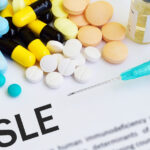Interferon blocker for SLE hits Australian first-time no go for PBS.
Interferon blocker for SLE hits Australian first-time no go for PBS.
In an initial setback for its manufacturer, AstraZeneca, anifrolumab was not recommended for a first ever targeted agent listing for systemic lupus in Australia, according to Pharmaceutical Benefits Advisory Committee (PBAC) meeting outcomes released on Friday night.
Anifrolumab, sold under the brand name Saphnelo, was considered for the first time at the July 2022 meeting of the PBAC, where rebates for Australian patients under the PBS are considered.
The interferon alpha/beta inhibitor has a successful phase 3 study, in the form of TULIP-2, first presented at ACR 2019 by Professor Eric Morand of Monash University, and last year was registered by the FDA for use in patients with SLE. While it was registered with Australia’s TGA in March of this year, unsubsidised medication costs have meant that it has been inaccessible for the vast majority of patients so far.
Following the publication of its registration trial in the New England Journal of Medicine in 2020, further data has helped to cement the nature of anifrolumab’s potential benefit. While interferon gene signature did not differentiate responding patients in TULIP-2, a recent post hoc analysis of pooled data from that study with the negative TULIP-1 indicated that patients with high expression of interferon gene signatures might have outsized benefit from anifrolumab.
The TULIP-LN1 phase 2 study in lupus nephritis missed its primary endpoint of change in baseline 24-hour urine protein–creatinine ratio at 52 weeks, but reported other positive results in the Annals of the Rheumatic Diseases in February of this year, and a phase 3 study is underway. Increased rates of herpes zoster have, however, been observed in patients receiving anifrolumab.
In the reported decision, it was noted that while the PBAC acknowledged the clinical need in the SLE patient population, “the PBAC considered the magnitude of benefit was modest and uncertain, and the incremental cost-effectiveness ratio was underestimated and highly uncertain.”
In response to the news, Monash Health’s Associate Professor Alberta Hoi said, “That’s a disappointing result, but it is along a similar theme as belimumab, which also has good RCT evidence of efficacy, but deemed too modest for PBAC recommendation for funding.
“It will be good to get better idea and comparison with other disease models for researchers to understand what cost-effective model may change current status quo. The health impact and burden of lupus patients continue to be a challenge for many without easy access to effective drugs.”
As Professor Hoi noted, belimumab (Benlysta) had been TGA listed for the systemic lupus indication but had failed to receive a listing, most recently in July 2020 in response to the BLISS-LN study.
In the documents from that time, the PBAC “acknowledged the clinical need for effective treatments for SLE, particularly for the group of patients who are not responding to current therapies” but the failure to reach a risk-sharing agreement meant that the sponsor, GlaxoSmithKline, could not satisfy the PBAC that the drug would not be widely used outside its indication.
In other outcomes:
Adalimumab (Yuflyma – Celltrion): request listing of biosimilar under same conditions as the reference biologic – recommended.
Polyethylene glycol 400 with propylene glycol (Optix – Petrus): request a restricted benefit listing of a new brand under the same conditions as the currently listed brand for patients with dry eye syndrome, including Sjogren’s syndrome – recommended.
Ustekinumab (Stelara – Janssen): request written authority listing for new form of ustekinumab for severe chronic plaque psoriasis and Crohn’s disease – recommended.
Full outcomes of the July PBAC meeting are available on the PBS website.






